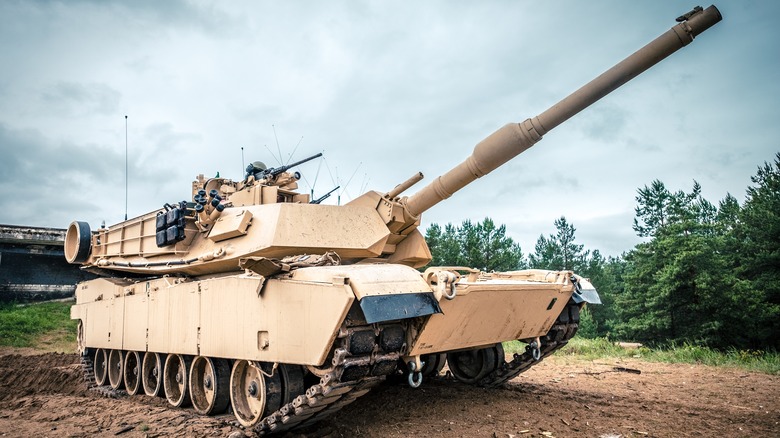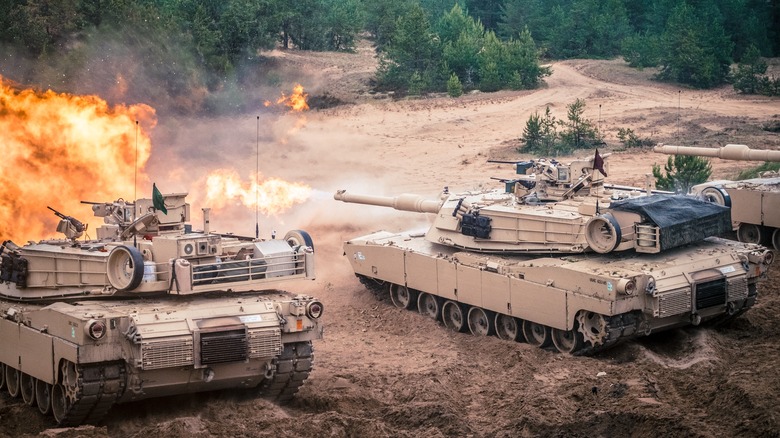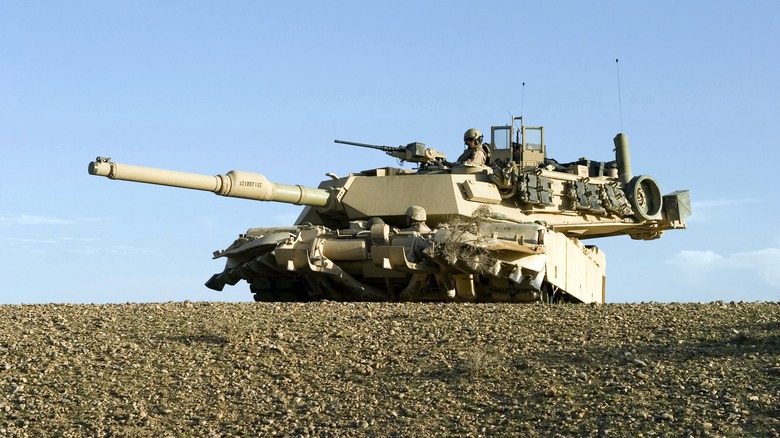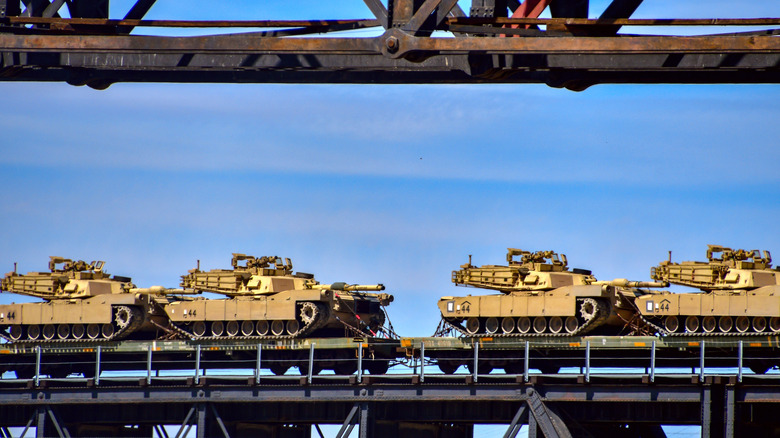Why The M1 Abrams Is Considered One Of The Best Tanks Ever Made
The M1 Abrams battle tank has remained the United States' primary ground combat armor since it entered service in 1980. The tank is a staple of the American military, and additional export varieties exist in service to the armed forces of Australia, Poland, Saudi Arabia, Egypt, Iraq, Kuwait, and Morocco. The versatility of the machinery makes it a devastatingly effective weapon of war, but its utility isn't the feature that has brought this tank into the limelight. In early 2023, the U.S. government announced that it would be sending 31 M1 Abrams tanks to Ukraine.
In Ukraine, the Abrams will be piloted by Ukrainian soldiers seeking to turn the tide of the war firmly in their favor. This shift in policy also marks the most dramatic show of support to date from the United States and the larger NATO alliance. The change is stunning, as the first year of fighting in Ukraine saw NATO member states walk a thin tightrope of lopsided neutrality to support Ukraine while remaining out of direct conflict with Russia. Early estimates placed delivery in the fall of 2023 – or perhaps by the end of the year if delays crept into the complex supply chain involved. Yet, leadership in Washington now appears anxious to complete the transfer rapidly.
The Abrams battle tank is one of the most impressive armored battlefield vessels ever created. Its prowess on the battlefield is underpinned by technological advancements that place the vehicle in a league of its own.
The Abrams' technically dominant specifications are vast
The United States Army Acquisition Support Center speaks to the potency of the vessel, noting that the Abrams enables "expeditionary Warfighters to dominate their adversaries through lethal firepower, unparalleled survivability, and audacious maneuver."
A blend of immense destructive capacity, armor, and agility combine to give the A1 Abrams tank its prowess on any battlefield. Underpinning the vessel is a 1,500 horsepower turbine engine and enough exterior and interior armor to withstand small arms fire with ease, shell fragments, and even the occasional direct hit from other explosive weaponry. The Abrams can travel across water with a depth of up to four feet and can reach a top speed of 45 miles per hour over a maximum range of 300 miles (doing 0-20 mph in just six seconds).
In addition to its armored body and propulsion system, the Abrams tank is outfitted with a grisly arsenal of weaponry. With those armaments, the four-person crew is capable of tackling a wide range of conditions on a myriad of battle landscapes. An M1A1 SA is outfitted with 40 rounds for its 120 mm cannon, alongside 900 rounds for the .50 caliber machine gun and 11,400 7.62 mm rounds for a secondary machine gun.
Superior situational awareness lies at the heart of the Abrams platform
From the first Abrams tanks to enter the fight, situational awareness has been a critical difference maker for the platform. The M1A1 model brought Forward-Looking Infrared (FLIR) sights to the cockpit, allowing the driver and weapons system operators to enjoy significant visibility while maneuvering in the armored vessel.
In addition, the M1A1 incorporates Blue Force Tracker technology. This is a digital command and control infrastructure that provides data on friendly forces sharing the battlefield. Enhancements in this segment of battlefield awareness make operating this deadly piece of equipment safer for both the tank crew and those joining them in combat against a hostile force.
The M1A2 System Enhanced Package (SEP) Version 4 is the most recent variant of the Abrams tank to hit the testing ground and is slated for the field in the 2025 fiscal year. This new Abrams will include an advanced sensor array, laser technology (including a laser range finder and a cross-platform laser pointer to augment driver functionality), and improved third-generation FLIR technology to improve targeting and enemy combatant identification from even greater distances than prior models.
American ground force capabilities have remained a priority
Perhaps the feature that helps the Abrams tank stand apart from its competition in European nations and elsewhere is the military focus that has been ingrained in American preparedness since the end of the Cold War.
The tank first entered service as an upgrade to the older Sherman tank that served in continental warfare a generation earlier. It was designed to quickly capture battlefield supremacy in the event of renewed warfare in the simmering theater. While other nations have allowed ground technology to wane in focus, favoring aerial developments or intelligence gathering capabilities, for instance, the United States has worked to spread its efforts firmly across a swath of tools. The result is a battle tank that has continued to improve with every new generation of production.
It's this commitment to consistent modernization of the arsenal that now stands ready to augment the Ukrainian war effort substantially. The modern Abrams tank incorporates enhanced armor and maneuverability, to be sure, but its communications and targeting equipment bring the tank to a new pinnacle of military innovation. These features make the M1 Abrams one of the most dangerous and technically proficient tools that an army can bring to the fight.



